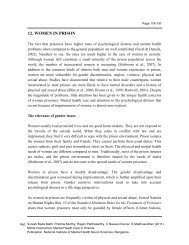An illicit alcohol production center in rural Bangalore - Nimhans
An illicit alcohol production center in rural Bangalore - Nimhans
An illicit alcohol production center in rural Bangalore - Nimhans
You also want an ePaper? Increase the reach of your titles
YUMPU automatically turns print PDFs into web optimized ePapers that Google loves.
8. Social, economic and political issues<br />
When one factors <strong>in</strong> earlier observations of dr<strong>in</strong>k<strong>in</strong>g patterns from India, one is tempted to<br />
speculate that there has been a dynamic shift from earlier permissive patterns represented by a<br />
relatively widespread use of a variegated spectrum of low <strong>alcohol</strong> beverages. The creation of<br />
<strong>alcohol</strong> monopolies dur<strong>in</strong>g the colonial period, resulted <strong>in</strong> the replacement of the traditional<br />
beverages with <strong>in</strong>dustrially produced high <strong>alcohol</strong> content beverages of questionable merit. Also, <strong>in</strong><br />
further<strong>in</strong>g the revenue aims of such monopolies, the pattern of use of <strong>alcohol</strong>ic beverages changed,<br />
as one notes from contemporary accounts. Home grown movements aga<strong>in</strong>st <strong>alcohol</strong> use such as the<br />
Devi movement <strong>in</strong> Gujrat, along with Temperance campaigns from the West, comb<strong>in</strong>ed with the<br />
process of sanskritisation to radically alter public attitudes towards <strong>alcohol</strong> use. This has resulted <strong>in</strong><br />
a pattern of <strong>alcohol</strong> use typically seen <strong>in</strong> temperance cultures, marked by a low prevalence of<br />
<strong>alcohol</strong> use <strong>in</strong> the population, but one <strong>in</strong> which <strong>alcohol</strong> users engage <strong>in</strong> b<strong>in</strong>ge dr<strong>in</strong>k<strong>in</strong>g, dr<strong>in</strong>k<strong>in</strong>g to<br />
<strong>in</strong>toxication <strong>in</strong> relatively solitary circumstances and act out on the basis of expectancies<br />
encourag<strong>in</strong>g hazardous use and dangerous <strong>alcohol</strong> <strong>in</strong>duced behaviors. All of which contribute to an<br />
<strong>in</strong>creased burden on health.<br />
There is concern that as a country like India moves from be<strong>in</strong>g a high mortality develop<strong>in</strong>g region<br />
to a low mortality develop<strong>in</strong>g region (a process currently well under way), the burden of health<br />
attributable to <strong>alcohol</strong> will represent the s<strong>in</strong>gle largest contributor to disability shift<strong>in</strong>g focus from<br />
micro-nutrient deficiencies. This is evident from the recent World Health Report 2002 (Ezzati et.<br />
al., 2002).<br />
Government monopolies have been shown to better serve the aim of regulation of <strong>alcohol</strong> use <strong>in</strong> the<br />
population. However, <strong>in</strong> India, where excise on <strong>alcohol</strong> forms the second largest source of revenue,<br />
sheer economic necessity will militate aga<strong>in</strong>st efforts to seriously enforce supply reduction<br />
strategies. The forces of the free market economy and commitments to world trade agreements have<br />
already opened the flood-gates for trans-national <strong>alcohol</strong> producers to dump cheap <strong>alcohol</strong>ic<br />
beverages <strong>in</strong> India as markets shr<strong>in</strong>k <strong>in</strong> the developed world. This, has already resulted, not <strong>in</strong><br />
supplant<strong>in</strong>g <strong>in</strong>digenous <strong>production</strong> but <strong>in</strong> <strong>in</strong>creas<strong>in</strong>g the availability of beverage <strong>alcohol</strong> <strong>in</strong><br />
circulation and consequent <strong>in</strong>creases <strong>in</strong> volumes sold and consumed. Experience <strong>in</strong> other<br />
develop<strong>in</strong>g economies has clearly demonstrated that the diffusion of European style commercial<br />
<strong>alcohol</strong>ic dr<strong>in</strong>ks adds to and modifies older patterns of dr<strong>in</strong>k<strong>in</strong>g, more than it substitutes, thus<br />
tend<strong>in</strong>g to <strong>in</strong>crease total consumption and dr<strong>in</strong>k<strong>in</strong>g situations. While considerable short term<br />
economic benefits accrue from the growth of <strong>alcohol</strong>ic beverage <strong>in</strong>dustries, <strong>in</strong> forms of profit,<br />
employment and taxes; at the same time, however, there is a gradual rise of long-term social and<br />
economic costs as a result of <strong>alcohol</strong> consumption.Attempts by the government to restrict the<br />
transnational companies by licens<strong>in</strong>g, jo<strong>in</strong>t ventures, sales of technology and similar means are<br />
usually <strong>in</strong>effectual as these means are shown to be as effective for the corporations as outright legal<br />
ownership <strong>in</strong> exercis<strong>in</strong>g <strong>in</strong>flueance. (McBride and Mosher, 1985).<br />
In a historical perspective, India has had no ma<strong>in</strong>streams of ideas either <strong>in</strong> medical or sociological<br />
research on <strong>alcohol</strong>ism. The trend dur<strong>in</strong>g the last 50 years or so, is reflected <strong>in</strong> the preoccupation<br />
with prohibition policies, which were <strong>in</strong>terwoven with<strong>in</strong> the freedom movement and f<strong>in</strong>ally laid out<br />
<strong>in</strong> Article 47 of the Directive Pr<strong>in</strong>ciples of the Indian Constitution. One reason is its close<br />
association with the political and moral movement reflected <strong>in</strong> the prohibition approach. Second, it<br />
did not appear as an issue of immediate or remote concern <strong>in</strong> national health policy. Health<br />
planners have tended to focus more on immediate problems eg. communicable diseases, nutrition<br />
and <strong>in</strong>fections rather than simultaneously plann<strong>in</strong>g preventive activites, <strong>in</strong> problems such as<br />
<strong>alcohol</strong>, road traffic accidents and <strong>in</strong>dustrial safety which will bear fruit <strong>in</strong> decades to come (Mohan<br />
& Sharma, 1985).<br />
86





